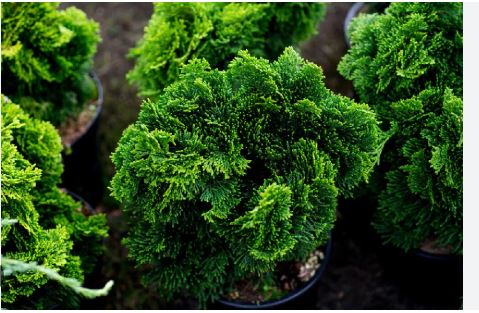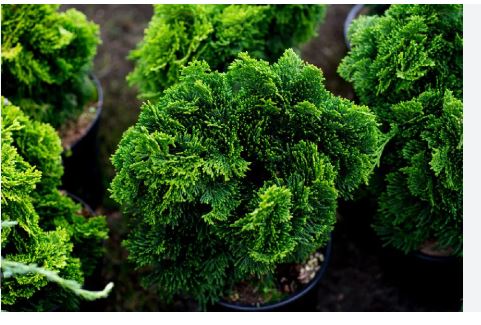
The Hinoki Cypress (Chamaecyparis obtusa), a revered evergreen conifer native to Japan, is celebrated for its lush, soft foliage, elegant form, and cultural significance. Known as “Hinoki” in Japanese, this tree is a staple in traditional gardens, temples, and modern landscapes, prized for its aromatic wood and ornamental versatility.
Its compact cultivars and graceful texture make it a favorite for bonsai, rock gardens, and urban plantings, while its durability and aesthetic appeal resonate globally. In this detailed guide, we explore the botanical classification, origin, identifying characteristics, habitat, distribution, USDA hardiness zones, uses, and fascinating facts about the Hinoki Cypress.
Botanical Classification, Origin and Native Area
The Hinoki Cypress, scientifically named Chamaecyparis obtusa, belongs to the Cupressaceae family, which encompasses cypresses, junipers, and cedars. It is classified within the genus Chamaecyparis, commonly known as false cypresses, alongside species like the Sawara Cypress (Chamaecyparis pisifera) and Lawson Cypress (Chamaecyparis lawsoniana).
The species name obtusa, meaning “blunt” in Latin, refers to the rounded tips of its scale-like leaves, distinguishing it from other conifers. As a gymnosperm, it produces cones rather than flowers, and its numerous cultivars, such as ‘Nana Gracilis’ (dwarf) and ‘Aurea’ (golden), showcase its horticultural diversity. Its taxonomic relatives include other Pacific Rim conifers, reflecting its adaptation to temperate climates.
The Hinoki Cypress is native to Japan, where it grows naturally in the mountainous regions of Honshu, Shikoku, and Kyushu, typically at elevations between 1,500 and 6,500 feet. It has been cultivated for centuries in Japanese gardens, temples, and shrines, valued for its fragrant, rot-resistant wood used in sacred architecture, such as the Ise Grand Shrine.
The tree holds deep cultural significance, symbolizing purity and longevity in Shinto traditions. Fossil records suggest that Chamaecyparis species were widespread across the Northern Hemisphere millions of years ago, with the Hinoki Cypress evolving to thrive in Japan’s cool, moist climate. Its cultivation has spread globally, making it a beloved ornamental in temperate regions.
Identifying Characteristics

The Hinoki Cypress is a medium to large conifer, growing 50–75 feet tall in the wild with a spread of 10–20 feet, though cultivated specimens and dwarf cultivars often remain much smaller (2–15 feet). Its pyramidal to conical crown is dense and symmetrical, with soft, scale-like leaves arranged in flattened, fern-like sprays. The foliage is dark green with a glossy texture, often with white, X-shaped markings on the undersides, and emits a pleasant, citrusy aroma when crushed.
The bark is reddish-brown, peeling in thin, fibrous strips, adding texture. The tree produces small, woody cones (0.3–0.5 inches), spherical and orange-brown, with 8–10 scales and tiny, winged seeds. Cultivars like ‘Nana Gracilis’ feature compact, cup-shaped foliage, while ‘Aurea’ has golden tips, enhancing its ornamental appeal.
Habitat

In its native habitat, the Hinoki Cypress thrives in cool, moist, mountainous environments, often in mixed conifer forests alongside pines, firs, and Japanese cedars. It prefers well-drained, slightly acidic soils (pH 5.0–6.5), typically loamy or sandy, but tolerates rocky or nutrient-poor conditions.
The tree requires full sun to partial shade, benefiting from Japan’s high humidity and frequent rainfall, and is moderately drought-tolerant once established. It is sensitive to waterlogged soils, which can lead to root rot, and prefers sheltered sites to avoid wind damage to its soft foliage. In cultivation, it adapts to urban and suburban landscapes, rock gardens, and containers, provided drainage and moisture are balanced.
Distribution
The Hinoki Cypress is naturally distributed across central and southern Japan, with significant populations in the Kiso Valley, Chichibu Mountains, and Kyushu’s highlands. Its cultivation in Japan dates back over a thousand years, with extensive planting in temple grounds and traditional gardens.
Globally, it has been widely introduced to temperate regions, including North America (particularly the U.S. Northeast and Pacific Northwest), Europe (UK, Germany), and parts of Australia and New Zealand. It is not invasive, as it rarely self-seeds aggressively, but its popularity as an ornamental has made it a common sight in gardens and nurseries. Conservation efforts in Japan focus on sustainable forestry to protect wild populations, which are harvested for their valuable wood.
USDA Hardiness Zones
The Hinoki Cypress thrives in USDA Hardiness Zones 4–8, tolerating minimum temperatures from -30°F to 10°F (-34°C to -12°C). It is best suited to cool, temperate climates with mild summers and cold winters, though it adapts to warmer zones with adequate moisture.
In Zone 4, young trees may require protection from harsh frost or drying winds, while in Zones 7–8, they flourish with minimal care, provided they are shielded from extreme heat. Its cold hardiness and moderate drought tolerance make it suitable for diverse landscapes, from northern gardens to coastal regions, though it may struggle in humid, subtropical climates.
Uses
The Hinoki Cypress is a versatile tree with significant ornamental, cultural, and practical applications. In landscaping, its elegant form and soft foliage make it a premier choice for specimen trees, hedges, screens, or rock gardens, particularly in Japanese-style or minimalist designs. Dwarf cultivars like ‘Nana Gracilis’ and ‘Kosteri’ are ideal for containers, bonsai, or small spaces, adding texture and year-round greenery.
Ecologically, it provides shelter for birds and stabilizes soil in cultivated settings. The tree’s aromatic, rot-resistant wood is highly prized in Japan for temple construction, furniture, and bath products (e.g., Hinoki oil-infused tubs), valued for its durability and pleasant scent. Its essential oil, extracted from leaves and wood, is used in aromatherapy, perfumes, and skincare for its calming and antimicrobial properties.
Culturally, the Hinoki Cypress is a symbol of purity in Shinto rituals, often planted near shrines or used in ceremonial objects. In urban environments, it enhances air quality and offers low-maintenance beauty, making it a favorite for sustainable landscaping.
Fun Facts
The Hinoki Cypress is steeped in intriguing facts that highlight its unique legacy. In Japan, some Hinoki trees are over 1,000 years old, with ancient specimens guarding sacred sites like the Ise Grand Shrine, which is rebuilt every 20 years using Hinoki wood to honor tradition. The tree’s wood is so durable that it was used in ancient Japanese palaces, with some structures surviving centuries.
Hinoki essential oil is a staple in luxury Japanese bathhouses, believed to promote relaxation and skin health. The tree’s compact cultivars are among the most popular choices for bonsai, with intricate specimens fetching high prices among collectors. Unlike true cypresses, the Hinoki’s false cypress classification reflects its distinct leaf structure, a subtle but fascinating taxonomic quirk. In folklore, Hinoki trees are said to house kami (spirits), reinforcing their spiritual significance. Additionally, the tree’s slow growth (1 foot per year or less) adds to its value, as mature wood is considered a premium resource in Japanese craftsmanship.
Cultivation of Hinoki Cypress (Chamaecyparis obtusa)
Cultivating the Hinoki Cypress (Chamaecyparis obtusa), a revered evergreen conifer native to Japan, is a delightful endeavor for gardeners and landscapers seeking to add elegance, texture, and cultural significance to their landscapes. Known for its soft, aromatic foliage, compact cultivars, and graceful form, this false cypress is ideal for Japanese-style gardens, rock gardens, bonsai, or urban plantings. While relatively low-maintenance, proper care is essential to ensure healthy growth and prevent issues like fungal diseases or winter damage.
- Climate Suitability: Hinoki Cypress thrives in USDA Hardiness Zones 4–8, tolerating minimum temperatures from -30°F to 10°F (-34°C to -12°C). It prefers cool, temperate climates with mild summers and cold winters but adapts to warmer zones with adequate moisture. In Zone 4, protect young trees from severe frost to prevent foliage damage.
- Site Selection: Choose a location with full sun to partial shade, receiving at least 4–6 hours of direct sunlight daily, to promote dense, vibrant foliage. Morning sun with afternoon shade is ideal in hotter climates to prevent leaf scorch. Ensure the site accommodates the tree’s mature size (50–75 feet for standard trees, 2–15 feet for dwarf cultivars) and offers wind protection.
- Soil Requirements: Plant in well-drained, slightly acidic soil (pH 5.0–6.5), such as loamy or sandy types. Hinoki Cypress tolerates nutrient-poor soils but is sensitive to waterlogged conditions, which cause root rot. Test soil drainage and amend with organic matter (e.g., compost) or sand to improve aeration and fertility if needed.
- Planting Time: The optimal planting seasons are early spring or fall, allowing roots to establish before summer heat or winter cold. Dig a hole twice as wide and as deep as the root ball, positioning the root collar at ground level. Backfill with native soil, tamp gently, and water thoroughly to settle the roots and eliminate air pockets.
- Watering Needs: Water young trees regularly (1–2 times weekly) for the first 1–2 years to establish a strong root system, keeping soil consistently moist but not soggy. Once established, Hinoki Cypress is moderately drought-tolerant but benefits from occasional deep watering during dry spells. Avoid overwatering, as excess moisture increases fungal risks.
- Mulching: Apply a 2–3 inch layer of organic mulch (e.g., pine bark, wood chips) around the base, extending to the drip line but keeping it 2 inches from the trunk. Mulch conserves moisture, regulates soil temperature, and suppresses weeds, supporting young trees and dwarf cultivars in containers or gardens. Replenish mulch annually.
- Fertilization: Fertilize sparingly in early spring with a balanced, slow-release fertilizer (e.g., 10-10-10) or one formulated for evergreens, using half the recommended rate to avoid over-fertilization, which can cause weak growth or needle burn. Mature trees and established cultivars rarely need supplemental feeding in fertile soils.
- Pruning: Prune minimally to maintain shape or remove dead, damaged, or crossing branches, ideally in late winter or early spring before new growth begins. Use clean, sharp shears for precise cuts. Dwarf cultivars like ‘Nana Gracilis’ require little shaping, but light trimming can enhance their compact form for bonsai or hedges. Avoid heavy pruning, as old wood regenerates slowly.
- Pest and Disease Management: Monitor for pests like spider mites, scale insects, or bagworms, treating infestations with insecticidal soap or neem oil. Hinoki Cypress is susceptible to root rot (Phytophthora) and tip blight in poorly drained or overly humid conditions. Ensure proper drainage, avoid overhead watering, and space trees to improve air circulation and reduce fungal risks.
- Spacing: Space standard trees 10–15 feet apart to accommodate their mature spread (10–20 feet), ensuring adequate sunlight and air circulation. For dwarf cultivars, space 2–5 feet apart for hedges or rock gardens, depending on the variety (e.g., ‘Kosteri’ or ‘Aurea’). Consider their height (2–75 feet, depending on cultivar) when planting near structures.
- Wind Protection: Young Hinoki Cypresses, with delicate foliage and shallow roots, are vulnerable to wind damage, especially in exposed areas. Stake newly planted trees for the first 1–2 years using flexible ties to allow slight trunk movement, which strengthens roots. Remove stakes once established to promote independent growth.
- Winter Care: In Zones 4–5, protect young trees from winter burn by wrapping them in burlap or applying an anti-desiccant spray to foliage. Water adequately before winter to prevent dehydration, as evergreens lose moisture through needles in cold, dry conditions. Mulch heavily around the base to insulate roots in northern climates. Mature trees are cold-hardy and require minimal winter care.
- Long-Term Growth: Hinoki Cypresses grow slowly (6–12 inches per year), reaching 50–75 feet for standard trees or 2–15 feet for dwarf cultivars, with lifespans of centuries in optimal conditions. Their soft foliage, aromatic wood, and compact forms make them ideal for bonsai, rock gardens, or specimen planting. Regular monitoring ensures health and structural integrity, particularly for container or urban plantings.